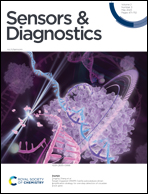Recent advances in DNA-based electrogenerated chemiluminescence biosensors
Abstract
Electrogenerated chemiluminescence (also called electrochemiluminescence and abbreviated as ECL) has witnessed significant development in fields ranging from biological analysis to clinical diagnosis due to its outstanding advantages such as high sensitivity, wide detection range, and low background signal. DNA, a class of biopolymers with programmable self-assembly and molecular recognition functions, is a significant tool in the field of ECL bioanalysis. Benefiting from the unique structures and excellent properties of DNA, DNA-based ECL biosensors have aroused increasing attention. In this review, we summarize and classify the signal output mode of DNA-based ECL biosensors and introduce the different methods for the immobilization of DNA probes on electrodes. In addition, we discuss the recent progress and applications of DNA-based ECL biosensors, including the detection of nucleic acids, proteins, and small biomolecules. Finally, we present a brief summary and prospects in this field.



 Please wait while we load your content...
Please wait while we load your content...